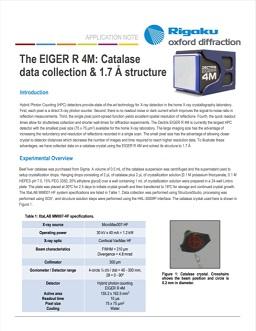Background
Hybrid Photon Counting (HPC) detectors provide state-of-the-art technology for X-ray detection in the home X-ray crystallography laboratory. First, each pixel is a direct X-ray photon counter. Second, there is no readout noise or dark current which improves the signal-to-noise ratio in reflection measurements. Third, the single pixel point-spread function yields excellent spatial resolution of reflections. Fourth, the quick readout times allow for shutterless collection and shorter wall-times for diffraction experiments. The Dectris EIGER R 4M is currently the largest HPC detector with the smallest pixel size (75 x 75 μm²) available for the home X-ray laboratory. The large imaging size has the advantage of increasing the redundancy and resolution of reflections recorded in a single scan. The small pixel size has the advantage of allowing closer crystal to detector distances which decrease the number of images and time required to reach higher resolution data. To illustrate these advantages, we have collected data on a catalase crystal using the EIGER R 4M and solved its structure to 1.7 Å.

